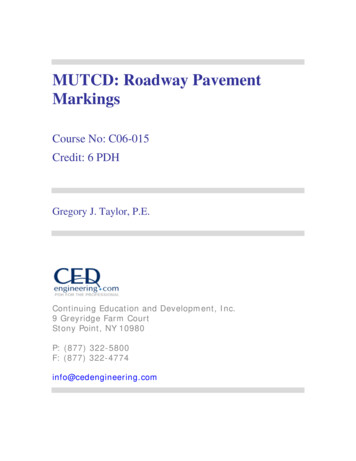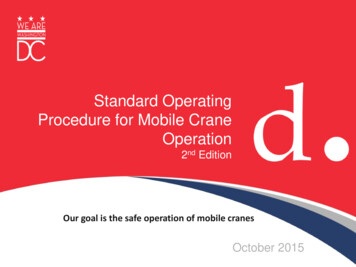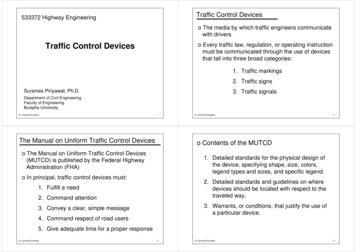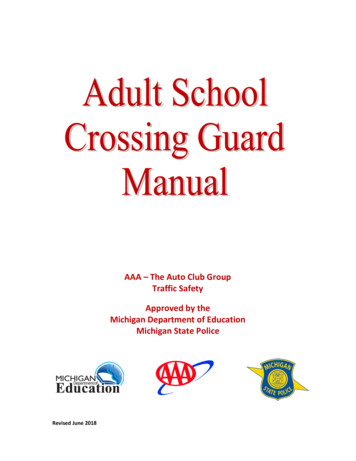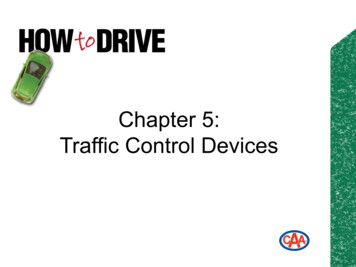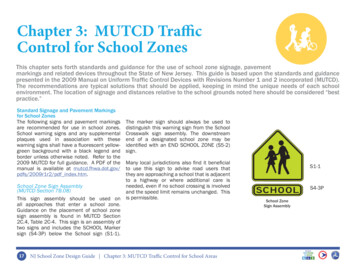
Transcription
Chapter 3: MUTCD TrafficControl for School ZonesThis chapter sets forth standards and guidance for the use of school zone signage, pavementmarkings and related devices throughout the State of New Jersey. This guide is based upon the standards and guidancepresented in the 2009 Manual on Uniform Traffic Control Devices with Revisions Number 1 and 2 incorporated (MUTCD).The recommendations are typical solutions that should be applied, keeping in mind the unique needs of each schoolenvironment. The location of signage and distances relative to the school grounds noted here should be considered “bestpractice.”The marker sign should always be used todistinguish this warning sign from the SchoolCrosswalk sign assembly. The downstreamend of a designated school zone may beidentified with an END SCHOOL ZONE (S5-2)sign.School ZoneSign Assembly7(1(' 2) 75 163257 ,781STEATERSOF NEW JE70,&OR'(3 5OF TRANSPNETEN1,2 7TMTHNJ School Zone Design Guide Chapter 3: MUTCD Traffic Control for School AreasS4-3PTIOTA17S1-1DEPARMany local jurisdictions also find it beneficialto use this sign to advise road users thatthey are approaching a school that is adjacentto a highway or where additional care isneeded, even if no school crossing is involvedSchool Zone Sign Assembly(MUTCD Section 7B.08)and the speed limit remains unchanged. ThisThis sign assembly should be used on is permissible.all approaches that enter a school zone.Guidance on the placement of school zonesign assembly is found in MUTCD Section2C.4, Table 2C-4. This sign is an assembly oftwo signs and includes the SCHOOL Markersign (S4-3P) below the School sign (S1-1).YStandard Signage and Pavement Markingsfor School ZonesThe following signs and pavement markingsare recommended for use in school zones.School warning signs and any supplementalplaques used in association with thesewarning signs shall have a fluorescent yellowgreen background with a black legend andborder unless otherwise noted. Refer to the2009 MUTCD for full guidance. A PDF of themanual is available at mutcd.fhwa.dot.gov/pdfs/2009r1r2/pdf index.htm.0 67 7(6 2) (5
School Advance Crossing Sign Assembly(MUTCD Section 7B.11)This sign assembly, while often misapplied, is used exclusively in conjunctionwith the School Crosswalk sign assembly as a means of advanced warning.This sign assembly is only used when the school crosswalk exists outside ofthe posted reduced school speed zone, and therefore acts in lieu of the SchoolZone sign assembly in those areas. This sign assembly should precede theSchool Crosswalk sign assembly in each direction by enough distance to allowa motorist to stop before the crosswalk. For example, a motor vehicle travelingon a level surface at a rate of 30 miles per hour (MPH) will need approximately200 feet to stop before a crosswalk. This distance will change depending onspeed and roadway conditions. See Table 2C-4 in the MUTCD for advancedplacement guidelines.S1-1S1-1W16-7P7(1(' 2) 75 163257 ,781STEATERSOF NEW JE70,&OR'(3 5OF TRANSPNETEN1,2 7TMTHNJ School Zone Design Guide Chapter 3: MUTCD Traffic Control for School AreasSchool Advance CrossingSign AssemblyTIOTA18Source: National Center for Safe Routes to SchoolDEPARSchool CrosswalkSign AssemblyW16-9PYSchool Crosswalk Sign Assembly(MUTCD Section 7B.12)This sign assembly is used to identify a crosswalkthat is not protected by a stop or yield sign or a trafficsignal. This sign is used primarily within the reducedschool speed zone and/or along established schoolwalking routes and/or where a significant studentcrossing exists. The School Crosswalk sign assemblyconsists of a School sign (S1-1) supplemented with adiagonal downward arrow (W16-7P) plaque. Guidanceon the placement of the school crosswalk signassembly can be found in the MUTCD Section 2A.16,Figure 2A-3. When used outside of the reducedschool speed zone, this sign must be accompanied bythe School Advance Crossing sign assembly.0 67 7(6 2) (5
All designated pedestrian crossings within a school zone and alongestablished school walking routes should be marked with a bar stylecrosswalk (also known as piano key or continental type). This ispreferred over the formerly conventional use of “zebra” stripes, dueto its visibility and durability. Marked crosswalks not protected bysignalization or stop control should always be accompanied by theSchool Crosswalk sign assembly. Additional protection may includein-street crosswalk signs, refuge islands, raised crosswalks and/orflashing beacons.School Sign AssemblySchool Area Sign, warns road users that they areapproaching a school area that may include schoolbuildings or grounds, a school crossing, or schoolrelated activity adjacent to the roadway.S1-1Marked Crosswalk (MUTCD Section 7C.02) Marked crosswalks alone, without other measures designed toreduce traffic speeds, shorten crossing distances, enhance driverawareness of the crossing, and/or provide active warning ofpedestrian presence, should not be installed across uncontrolledroadways where the speed limit exceeds 40 mph and either: The roadway has four or more lanes of travel without a raisedmedian or pedestrian refuge island and an ADT (average dailytraffic) of 12,000 vehicles per day or greater; -or The roadway has four or more lanes of travel with a raised medianor pedestrian refuge island and an ADT of 15,000 vehicles perday or greater.S4-3PW16-9PW16-7P School Zone Assembly, used to warnroad users that they are approachinga designated school zone School Advance Crossing Assembly,used to warn road users that theyare approaching a crossing whereschool children cross the roadway School Crossing Assembly, used towarn approaching road users of thelocation of a crossing where schoolchildren cross the roadwayBar style crosswalk in Hoboken, NJ.Image: The RBA Group(' 2) 75 163257 ,77(1,&Y7081STEATERSOF NEW JE'(3 5OR1,2 7DEPAROF TRANSPNETHNJ School Zone Design Guide Chapter 3: MUTCD Traffic Control for School AreasTENTIOTA19TM0 67 7(6 2) (5
Distracted Driving in School ZonesOF TRANSPOR7(1(' 2) 75 1632571,2 7,781STEATERSOF NEW JE70 TENNETHNJ School Zone Design Guide Chapter 3: MUTCD Traffic Control for School AreasTMTIOTA20Resources Safe Kids USA, “Characteristics ofDistracted Drivers in School Zones: ANational Report,” 2009 sschool-zones-national-report-2009 National Center for Safe Routes toSchool, “Getting Results: SRTS ProgramsThat Reduce Speeding and default/files/resources/sr tsgettingresults drivingbehavior 0.pdf Official US Government Website forDistracted Driving, www.distraction.gov/ Strayer DL, Drews FA, Crouch DJ. (2006).“A comparison of the cell phone driverand the drunk driver.” Hum Factors.2006; 48: 381-91. on-ofCellPhone-Driver-Drunk-Driver.pdf,&The study also found that having a law onthe books may somewhat decrease theprevalence of distracted driving. The study,which covered communities in 15 states,showed that those states with laws regulatingcell phone or hand-held electronic device usein a vehicle were 13 percent less likely tohave distracted drivers in school zones. NewJersey law bans the use of hand-held devicesand texting for all drivers (N.J.S.A. 39:4-97.3).Hands-free cell phone use is also prohibitedfor bus drivers and novice drivers. New Jerseydefines novice drivers as those under the ageof 21 with a GDL or a provisional license.Source: MyParkingSign.com'(3 5Distracted driving draws driver attention offthe road and away from the primary task ofdriving. This lengthens reaction time andputs pedestrians, bicyclists, drivers andpassengers at greater risk. Research fromSafe Kids USA shows that one out of everysix drivers in school zones is distracted bythe use of cell phones, eating, drinking,smoking, reaching behind, groomingand reading. The study, “Characteristicsof Distracted Drivers in School Zones: ANational Report,” consisted of more than40,000 observational road-side surveysconducted by local Safe Kids researchersFindings from the study include: The majority of distracted drivers wereobserved during the afternoon school zonehours as compared to the morning hours. Distracteddriversappearedmorefrequently in school zones without flashinglights and in school zones that had a dailytraffic volume of 10,000 or more cars. Drivers of larger vehicles such as sportsutility vehicles, pickup trucks, and minivanswere more distracted than car drivers.DEPARin 20 locations across the United States. Useof electronics (such as cell phones, PDAs andSmartphones) was the leading category ofdistraction while driving at 9.8 percent.YDistracted driving (including talking ortexting on cell phones, using GPS fornavigation, eating, and listening to music)around schools can adversely impact safetyfor children walking and bicycling to schooland influence parent decisions about howchildren will get between home and school.Research indicates that the probability andseverity of a crash taking place are stronglyinfluenced by driver attention. Variousstudies have documented an almost sixtimes greater risk when dialing a phone and23 times greater risk when texting. Otherstudies show that using a cell phone whiledriving delays your reaction time as muchas having a blood alcohol concentration of.08, the legal limit for drunk driving.0 67 7(6 2) (5
Optional Signs & Pavement Markings for School Zones7(1(' 2) 75 163257 ,781STEATERSOF NEW JE70,&OR'(3 5OF TRANSPNETEN1,2 7TMTHNJ School Zone Design Guide Chapter 3: MUTCD Traffic Control for School AreasWarning Beacon in Haddon Heights,NJ. Image: The RBA GroupTIOTA21End School SpeedLimit SignThis system is most effectively applied toarterial and/or multi-lane roadways wheredrivers would not otherwise note school zonesignage due to traffic conditions, speed oftravel, and competing signage. The flashinglights should be timed to correspond toschool arrival and dismissal times. Warningbeacons may also be used with the SchoolCrosswalk Sign Assembly or School AdvanceCrossing Sign Assembly.DEPARSchool Speed LimitSign AssemblyWarning Beacons (MUTCD Section 4L.03)Warning Beacons can be used to callattention to a School Speed Limit signassembly or a School Zone sign assembly.Flashing yellow beacons are one of the mosteffective safety improvements a school canmake, as they have been shown to decreasevehicle speeds an average of five to sevenmiles per hour in school zones. The “WhenFlashing” marker should be used if the signis automated with a flashing beacon. If notautomated with a beacon, the marker signshould read “When Children are Present.”This marker is preferred over a sign thatlists school times, as school hours vary fromyear to year, and the information is often toosmall and complex to be comprehended by apassing driver.YSchool Speed Limit Sign Assembly and END SCHOOLSPEED LIMIT Sign (MUTCD Section 7B.15)This sign assembly is used where a reduced schoolspeed limit zone has been established. The SchoolSpeed Limit assembly is placed at or as near as practicalto the point where the reduced school speed limitzone begins. However, the School Zone sign assemblymust be installed in advance of the first School SpeedLimit sign assembly. In addition, the downstream endof a designated reduced speed school zone shouldbe identified with an End School Speed Limit sign. Astandard Speed Limit sign showing the speed limit forthe section of highway that is downstream from theauthorized and posted reduced school speed limit zonemay be mounted on the same post above the ENDSCHOOL SPEED LIMIT sign (S5-3).0 67 7(6 2) (5
“Slow School” Pavement Markings(MUTCD Section 7C.03)This pavement marking should be used as anadditional warning where vehicle speeds area concern. It should be placed in proximityto reduced school speed zones or SchoolSpeed Limit sign assemblies. These markingsare most effective on single lane local orcollector streets, where they are visible froma distance and not obscured by heavy vehicletraffic. This application offers a cost-effectivealternative to flashing beacons and may bemore appropriate in a residential environmentwhere flashing beacons may not be desirable.In-Street Crosswalk Signs(MUTCD Section 7B.12)The In-Street Pedestrian Crossing (R1-6a)sign or the In-Street Schoolchildren Crossing(R1-6c) sign may be used at mid-blockcrosswalks that are not protected by stop signsor signalization. If the In-Street PedestrianCrossing (R1-6a) sign is used at a schoolcrossing, a 12 x 4-inch SCHOOL (S4-3P)plaque may be mounted above the sign.The sign is placed on the yellow centerlineimmediately adjacent to (not within) thecrosswalk. It should be placed on the sideof the crosswalk that most vehicles approachfrom or as geometry permits. They are moreeffective on unsignalized two-lane low-speedstreets than on multi-lane high-speed streets.They can be easily damaged and need to bereset or replaced when struck. When portablein-street signs are used for school crossings,they should be monitored by a school officialor school crossing guard.Vertical Reflective Strip(MUTCD Section 2A.21)This reflective strip should be used at stopcontrolled intersections that have crosswalkswithin the school zone and along schoolwalking routes to call extra attention to thestop sign. Reflective fluorescent yellow-greenstrips may also be used on School Area signs.The strip shall be at least 2 inches in widthand placed for the full length of the post fromthe sign to within 2 feet above the edge of theroadway. The color of the reflective strip mustmatch the sign background, except that thecolor of the strip for the YIELD and DO NOTENTER signs shall be red.“Slow School” pavement markings on Glenwood Avenuein East Orange, NJ. Image: The RBA GroupReflective tape on stop sign post inNewark, NJ. Image: The RBA Group7(1(' 2) 75 163257 ,781STEATERSOF NEW JE70,&OR'(3 5OF TRANSP1,2 7DEPARTENNETHNJ School Zone Design Guide Chapter 3: MUTCD Traffic Control for School AreasTMTIOTA22R1-6CYR1-6A0 67 7(6 2) (5
Sign PlacementWhile the MUTCD providesguidance for the type ofsignage and its application,the placement of school zonesignage is often dictated bystandards set forth by stateand local jurisdictions. NewJersey has no such standards,therefore the location of signsand distances relative to theschool zone recommendedhere should be considered“best practice.” Refer to thediagram for sign placement.Signs should be usedjudiciously, as overuse maylead to driver noncomplianceand excessive signs maycreate visual clutter.Where practical,signs can becombined onone post toreduce signclutter. Image:MinnesotaDepartment ofTransportationGraphic: Fitzgerald & Halliday, Inc.(' 2) 75 163257 ,77(1,&Y7081STEATERSOF NEW JE'(3 5OR1,2 7DEPAROF TRANSPNETHNJ School Zone Design Guide Chapter 3: MUTCD Traffic Control for School AreasTENTIOTA23TM0 67 7(6 2) (5
Signage Selection MatrixSigns must be selectedin response to the type ofroadway and pedestriancrosswalkfacilitieslocated within proximityof a school. The followingmatrix should be usedas a guide for signageoptions.Local orCollectorStreetArterialStreet orMulti-LaneStreetStreets w/Speed limit30 mph oraboveMidblockCrosswalkwithinSchool ZoneMidblockCrosswalkoutside ofSchool ZoneSchool Warning Sign(S1 S4-3P)Crosswalk WarningSign(S1 W16-9P)Crosswalk Sign(S1 W16-7P)In-Street CrosswalkSign(R1-6C)School Speed LimitSign(S4-3P R2-1 S4-2P) or(S4-4P)Flashing BeaconSlow SchoolPavement MarkingOversized Signage7(1(' 2) 75 163257 ,781STEATERSOF NEW JE70,&OR'(3 5DEPAROF TRANSPNETEN1,2 7TMTHNJ School Zone Design Guide Chapter 3: MUTCD Traffic Control for School AreasTable: Fitzgerald & Halliday, Inc.TIOTA24Standard ApplicationYOptional Application0 67 7(6 2) (5
Size of School Signs (MUTCD Section 7B.01)The sizes of signs and plaques to be used onconventional roadways in school areas shallbe as shown in the table below. The sizes inthe Conventional Road column shall be usedunless engineering judgment determinesthat a minimum or oversized sign sizewould be more appropriate. The sizes in theMinimum column shall be used only wheretraffic volumes are low and speeds are 30mph or lower, as determined by engineeringjudgment. The sizes in the Oversized columnshould be used on roadways that have fouror more lanes with posted speed limits of40 mph or higher. The sizes in the Oversizedcolumn may also be used at other locationsthat require increased emphasis, improvedrecognition or increased legibility.7(1(' 2) 75 163257 ,781STEATERSOF NEW JE70,&OR'(3 5DEPAROF TRANSPNETEN1,2 7TMTHNJ School Zone Design Guide Chapter 3: MUTCD Traffic Control for School Areas.TIOTA25.Y.0 67 7(6 2) (5
School Crosswalk sign assembly in each direction by enough distance to allow a motorist to stop before the crosswalk. For example, a motor vehicle traveling on a level surface at a rate of 30 miles per hour (MPH) will need approximately 200 feet to stop before a crosswalk. This distance will change depending on
